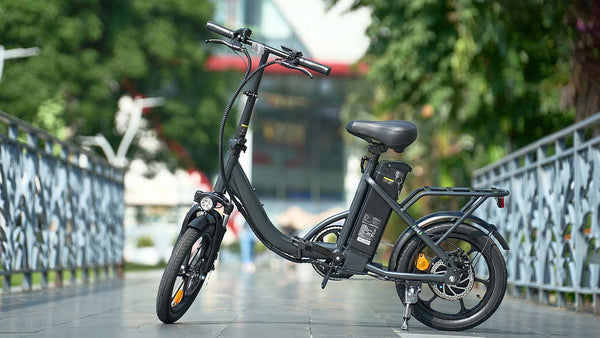
Are Electric Bikes Worth It? Benefits, Costs, and Everything You Need to Know
As cities get busier, fuel prices climb, and environmental concerns grow, more people are searching for smarter ways to get around. Enter electric bikes—an innovative blend of traditional cycling and modern technology. With a built-in motor and rechargeable battery, e-bikes promise faster commutes, easier hill climbs, and a greener footprint. But with higher upfront costs than standard bicycles, many wonder: are electric bikes worth it?
In this article, we’ll explore the benefits, limitations, and long-term value of e-bikes so you can decide whether they’re a smart investment for your lifestyle.
What Are Electric Bikes?
Electric bikes, or e-bikes, are bicycles equipped with a motor and rechargeable battery that offer pedal assistance. They don’t replace pedalling but enhance it, making it easier to climb hills, cover longer distances, and arrive at your destination feeling fresh.
At their core, e-bikes combine three key components: the motor, which provides power; the battery, which dictates range; and the pedal-assist system, which determines how much help the motor delivers as you ride. This system relies on either cadence sensors, which sense your pedalling speed and adjust power output accordingly, or torque sensors, which respond to how hard you pedal—offering a smoother and more intuitive riding experience.
By reducing physical strain and offering customizable ride experiences, e-bikes open the door to cycling for a broader group—whether you’re less conditioned, recovering from injury, or tackling tough terrain.
Commuter Electric Bikes
Commuter e-bikes are designed with practicality and comfort in mind, making them ideal for daily journeys to work, school, or around town. They often feature upright seating, integrated lights, and accessories like racks or mudguards to handle urban riding with ease. From iHoverboard’s range, the Ucity stands out for its stylish design and everyday comfort, while the U2 combines ease of use with reliability, making both excellent choices for commuters looking for a dependable ride.
Folding Electric Bikes
Folding e-bikes focus on portability, allowing riders to fold them down for storage in small spaces or to carry them onto public transport. They typically come with smaller wheels and lightweight frames, making them particularly useful for city dwellers or those who need flexibility in their commute.
In iHoverboard’s collection, the U1 offers a compact and intelligent design, while the U3 provides a portable, easy-to-store option perfect for multi-modal commuting. The U4 adds a balance of foldability and stability, making it another versatile choice for riders who want convenience without sacrificing comfort.
Electric Mountain Bikes
Electric mountain bikes, or e-MTBs, are built to handle tougher terrain with robust frames, suspension systems, and more powerful motors. They are designed for riders who enjoy off-road trails, steep inclines, or adventurous weekend rides. Among iHoverboard’s lineup, the M10 is the dedicated electric mountain bike, offering a smooth yet powerful riding experience that makes it well-suited for tackling challenging landscapes while still providing comfort for longer rides.
Electric Bikes vs Regular Bicycles – Benefits, Costs & Comparison
When deciding whether to invest in an electric bike, it’s important to compare electric bikes to traditional bicycles. Both options have unique advantages depending on your needs, lifestyle, and riding goals.
Speed and Efficiency Comparison
Regular bicycles rely entirely on human power, and the speed you achieve depends on your fitness level, terrain, and effort. Most riders maintain 10–20 mph (16–32 km/h) on flat ground, which is fine for short trips but can be exhausting over longer distances or hilly routes. Electric bikes, on the other hand, provide motor assistance that allows you to reach higher speeds—typically 20–28 mph (32–45 km/h) depending on the bike and assist mode—while using significantly less effort. This makes electric bikes particularly suitable for commuting, longer rides, or tackling challenging inclines. Electric bikes win for speed and efficiency, as they let riders travel faster and farther without excessive physical exertion.
Exercise Benefits Compared to Regular Bikes
Riding a regular bicycle offers a full-body cardiovascular workout, improving stamina, muscle strength, and calorie burn. Electric bikes provide flexibility: their pedal-assist system allows riders to choose the level of effort they want to exert. You can ride almost like a traditional bike for a more intense workout or rely more on the motor for an easier ride. This makes electric bikes ideal for people with limited fitness, mobility challenges, or those easing back into exercise. Traditional bikes offer more intense exercise, but electric bikes provide adjustable effort, making cycling accessible to a wider range of riders.
Electric Bikes for Commuting vs Traditional Bikes: Practicality and Convenience
Traditional bikes are simple, low-maintenance, and great for short to medium distances. However, longer rides, hilly commutes, or trips in hot weather can be physically demanding. Electric bikes offer a practical solution for these scenarios: the motor assistance makes hills, long distances, and carrying loads much easier. They also reduce sweat and fatigue, making them ideal for commuting without the need for showers or a change of clothes at work. Electric bikes are more practical for commuting and longer rides due to their motor support and comfort.
Electric Bike vs Regular Bike Costs and Maintenance Explained
Regular bicycles are generally more affordable, require less maintenance, and have fewer mechanical components that could fail. Routine care usually involves tire checks, chain lubrication, and occasional brake adjustments.
Electric bikes, by contrast, are more expensive upfront due to the motor, battery, and electronic components. Maintenance can include battery care, motor servicing, and occasional software updates, though they still cost far less to operate than a car. Regular bicycles win for lower upfront cost and simpler maintenance, though electric bikes provide savings compared to fuel-based transportation.
In summary, electric bikes excel in speed, commuting practicality, and accessibility, while regular bikes remain unbeatable for low cost, simplicity, and intense exercise. Choosing between the two depends largely on your priorities: if convenience, range, and ease are most important, electric bikes are worth it. If fitness, affordability, and simplicity are your main goals, a traditional bicycle may be sufficient.
Benefits of Electric Bikes: Health, Commuting, and Environmental Advantages
Environmental Benefits
Electric bikes offer a greener alternative to traditional transportation, producing little to no tailpipe emissions and helping reduce greenhouse gases. They are highly energy-efficient, converting battery power into movement with minimal waste compared to cars or motorcycles. By replacing short car trips with electric bike rides, riders also help reduce traffic congestion and noise pollution in urban areas. Additionally, electric bikes require less parking space and promote better land use in cities, allowing streets to be more pedestrian-friendly and opening space for parks and cycling infrastructure.
Health and Fitness Benefits
Riding an electric bike provides customizable exercise. With adjustable pedal-assist levels, riders can choose how much effort to exert, making cycling accessible to people of all fitness levels or those returning from injury. Regular rides improve cardiovascular health, aid weight management, and offer a low-impact, joint-friendly workout that protects knees and hips. Beyond physical benefits, electric biking supports mental well-being, reducing stress and improving mood through outdoor activity. It also encourages increased daily activity, allowing busy individuals to integrate exercise into their routine without needing extra gym time.
Commuting and Transportation Benefits
Electric bikes make commuting faster, easier, and less tiring. The motor assistance reduces sweat and fatigue, allowing riders to arrive at work or appointments feeling fresh. Flexible assistance levels let riders adjust effort according to terrain or energy levels. Using an electric bike also saves money on fuel, parking, and public transport, while avoiding traffic jams and delays. Riders enjoy seamless door-to-door travel, bypassing the need for transfers or waiting for public transportation, making commuting more convenient and time-efficient.
Cost Efficiency
Although electric bikes require a higher initial investment than traditional bicycles, they offer significant long-term savings. Charging an electric bike costs far less than fueling a car, and maintenance is typically simpler and cheaper than that for motor vehicles. In many regions, insurance or registration is not required, further reducing costs. Additionally, the health benefits of regular cycling may decrease medical expenses over time, offering indirect financial savings through a healthier lifestyle.
Accessibility and Inclusivity
Electric bikes make cycling accessible to a wider range of people. The motor provides uphill and long-distance support, enabling riders of all fitness levels to enjoy longer or more challenging rides. They also serve as an alternative to driving for individuals without a license, providing independence and mobility. Electric bikes support inclusive group riding experiences, allowing people with different abilities to cycle together, making biking a social and enjoyable activity for everyone.
Limitations of Electric Bikes: What You Need to Know Before Buying
While electric bikes offer numerous advantages, it’s important to consider their limitations before investing.
Range and Battery Life
One of the main factors is range and battery life. Depending on battery capacity, terrain, rider weight, and assistance level, electric bikes can only travel a certain distance on a single charge. Longer rides may require careful planning or additional charging, though riders can still pedal manually if the battery runs low.
Charging Time
Charging time is another consideration. Electric bike batteries typically take several hours to recharge, which may be inconvenient for riders who need to use their bike multiple times a day or on longer journeys.
Weight and Maneuverability
Electric bikes are generally heavier than traditional bicycles due to the motor, battery, and reinforced frame, which can make lifting or maneuvering them at slow speeds more challenging.
Cost and Maintenance
Electric bikes cost more than regular bicycles because of sophisticated motors, batteries, and electronic components. Although this is often offset by savings on fuel, parking, and public transport, the initial investment can be a barrier. Maintenance and repairs may also be more complex, requiring attention to specialized components.
Safety Considerations
Electric bikes can reach higher speeds than conventional bicycles, which may increase braking distance and affect handling. Riders need to practice controlling the bike, especially on turns or in traffic. Battery safety is generally reliable, but following the manufacturer’s guidelines for charging, storage, and usage is essential.
Terrain Limitations
While electric bikes handle a variety of terrains, they may not perform as well on extremely steep hills or rugged off-road trails compared to specialized mountain bikes.
Despite these limitations, electric bikes remain a practical, eco-friendly, and enjoyable mode of transportation, especially when weighed against the convenience, health benefits, and cost savings they offer over traditional vehicles.
Why Are Electric Bikes So Popular?
Electric bikes have surged in popularity in recent years due to their convenience and inclusivity. They make cycling accessible to a wider range of people, including those with limited fitness, mobility challenges, or longer commutes. With adjustable pedal-assist levels, riders can choose how much effort to exert, making daily rides more enjoyable and less physically demanding.
Urban commuters particularly benefit from electric bikes, as they allow faster travel across cities while avoiding traffic congestion and reducing reliance on cars or public transport. The ability to carry groceries, luggage, or even children with ease adds to their practicality for everyday life.
Government incentives have further boosted the appeal of electric bikes. In the UK, schemes such as the Cycle to Work program provide tax advantages, making electric bikes more affordable and encouraging environmentally friendly commuting.
Finally, electric bikes are part of the broader micro-mobility trend, which emphasizes small, lightweight, and sustainable transportation solutions. As cities become more congested and environmentally conscious, electric bikes offer a practical, eco-friendly, and fun way to get around, solidifying their role in modern urban mobility.
Conclusion – Are Electric Bikes Worth It?
Electric bikes offer a range of advantages, including convenience, accessibility, improved health, and reduced environmental impact, but they also come with challenges like upfront costs, battery maintenance, and limited range. Whether an electric bike is worth it ultimately depends on your lifestyle, commuting needs, fitness goals, and budget.
For many riders, electric bikes provide long-term savings on transport, make daily exercise easier, and offer a practical, eco-friendly alternative to cars. They are also enjoyable and flexible, allowing riders to choose how much effort they want to exert.
In conclusion, yes, electric bikes are worth it for anyone looking for a sustainable, practical, and fun mode of transportation that fits modern commuting and recreational needs.
FAQs
How Much Does an Electric Bike Cost?
The cost of an electric bike varies depending on features, battery range, and build quality. Entry-level models start around €200–€300, mid-range bikes typically cost €300–€500, and high-end models are priced from €500 and above. While the upfront cost is higher than a regular bike, electric bikes often save money in the long run through lower commuting, fuel, and maintenance expenses.
For those looking to get started, iHoverboard offers a range of electric bikes to suit different budgets and needs. Entry-level riders can consider the U1, while commuters may prefer the U3 for portability. For a premium experience, the U2, U4, and Ucity provide extended range, comfort, and reliable performance for daily rides.
Can You Ride an Electric Bike Without Pedaling?
Yes, many electric bikes offer a throttle mode that allows you to ride without pedaling, though this depends on the model. However, most electric bikes use pedal-assist, which means the motor provides power only when you pedal, helping you go farther and faster with less effort while still getting some exercise.
Are Electric Bikes Faster Than Regular Bicycles?
Yes, electric bikes can reach higher speeds than regular bicycles with less effort, thanks to their motor assistance. While traditional bikes rely entirely on your pedaling power, electric bikes allow riders to maintain faster speeds, especially on hills or longer commutes, making them a more efficient option for many riders.
How Many Years Will an Electric Bike Last?
The lifespan of an electric bike depends on usage, maintenance, and battery care. With proper maintenance, most electric bikes can last 5 to 10 years, while the battery may need replacement every 2 to 5 years depending on charging habits and frequency of use. Regular servicing and proper storage can help extend the bike’s overall longevity.
How Long Does It Take to Charge an Electric Bike?
Charging an electric bike typically takes 3 to 6 hours, depending on the battery capacity and charger used. Some high-capacity batteries may take longer, while smaller batteries can charge faster. It’s best to follow the manufacturer’s instructions to ensure safe and efficient charging.
Product Category
Recent Posts

How to Remove the Speed Limiter on Your Electric Bike: Step-by-Step Guide

How to Charge an Electric Bike Safely and Effectively

Are Electric Bikes Worth It? Benefits, Costs, and Everything You Need to Know

Best Electric Bikes Under £500 – Top Affordable iHoverboard Picks for Adults



























































Still, need help? Contact Us: support@ihoverboard.com
What's the option? Check out the option now!
Leave us a message